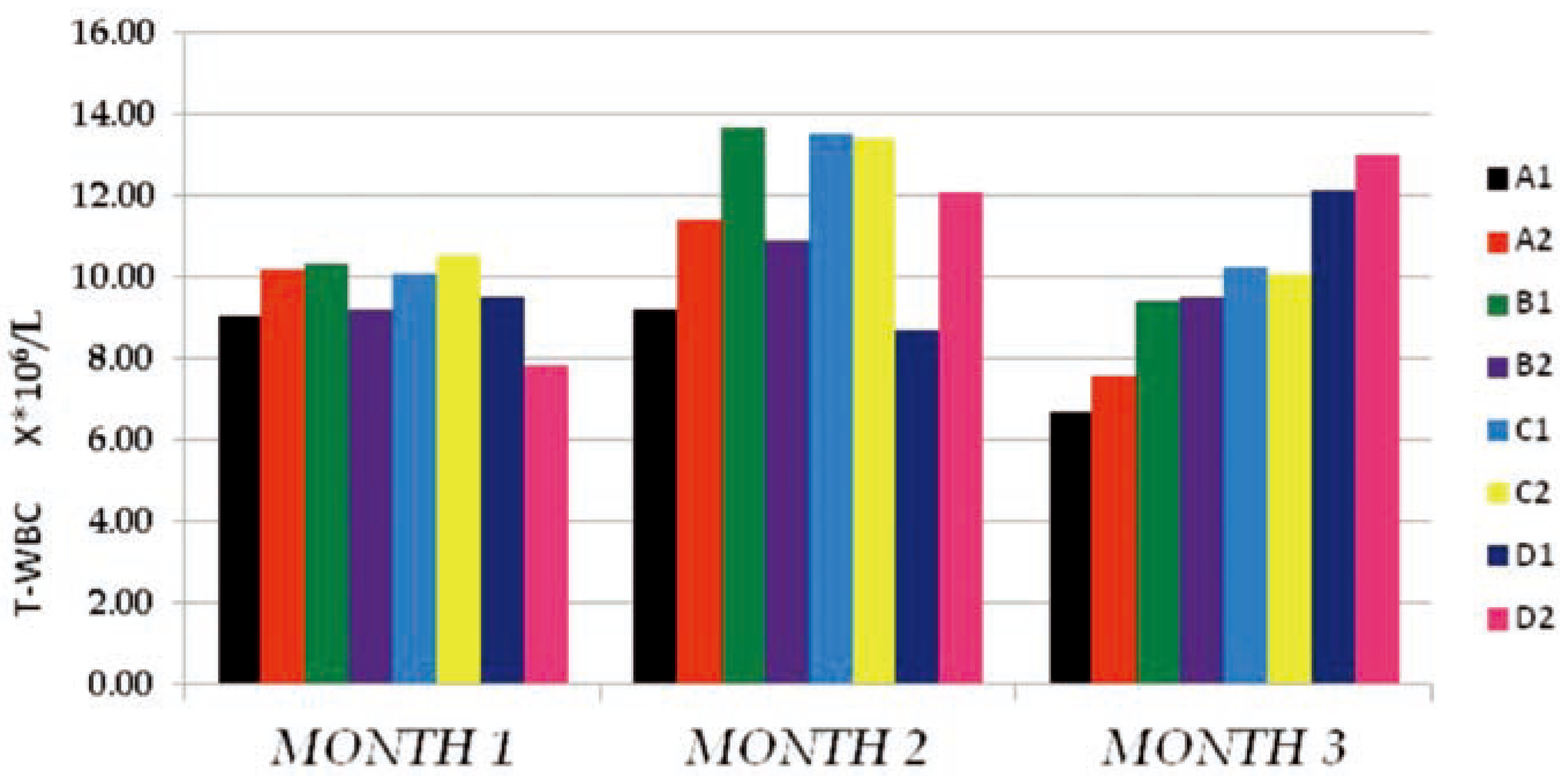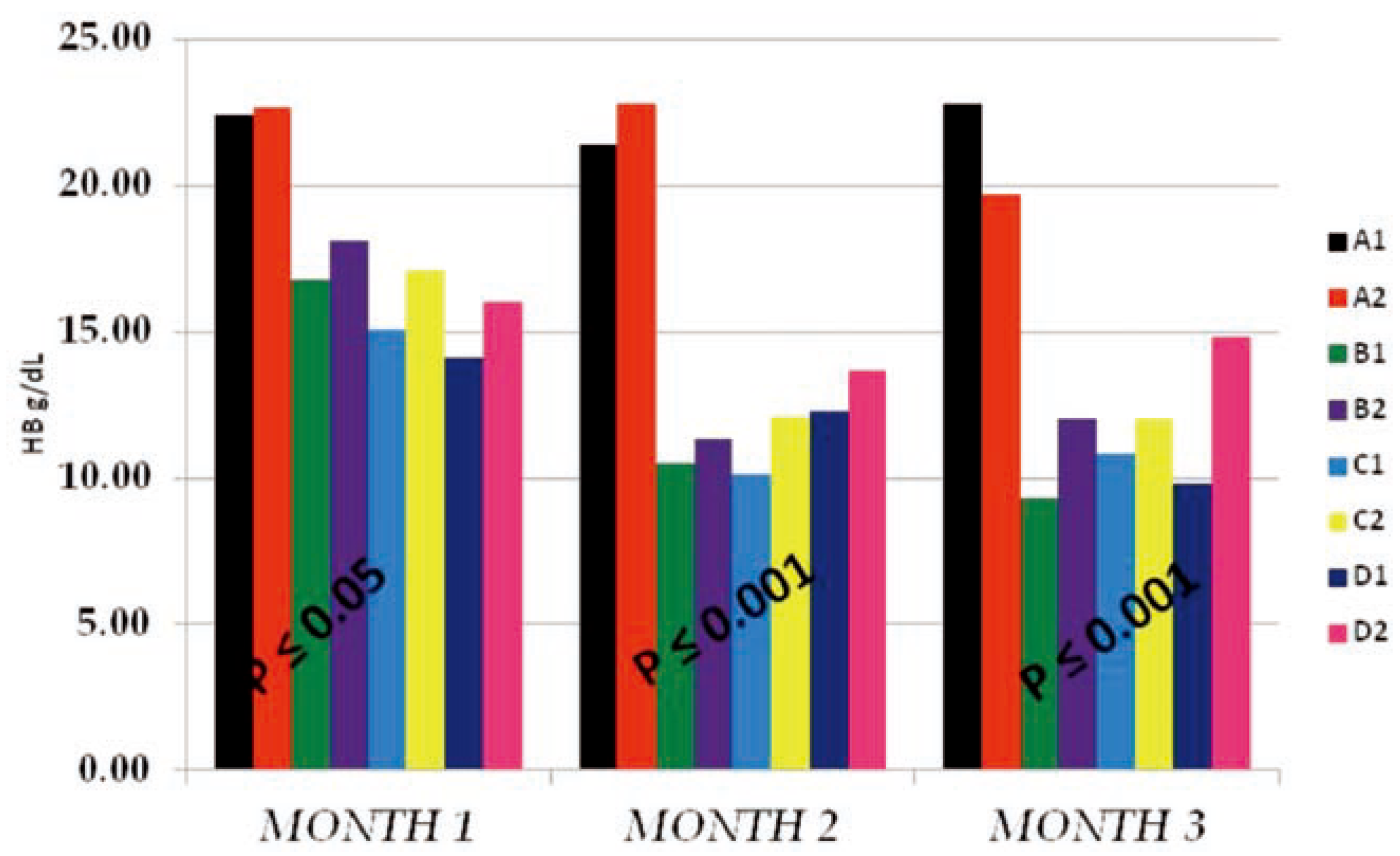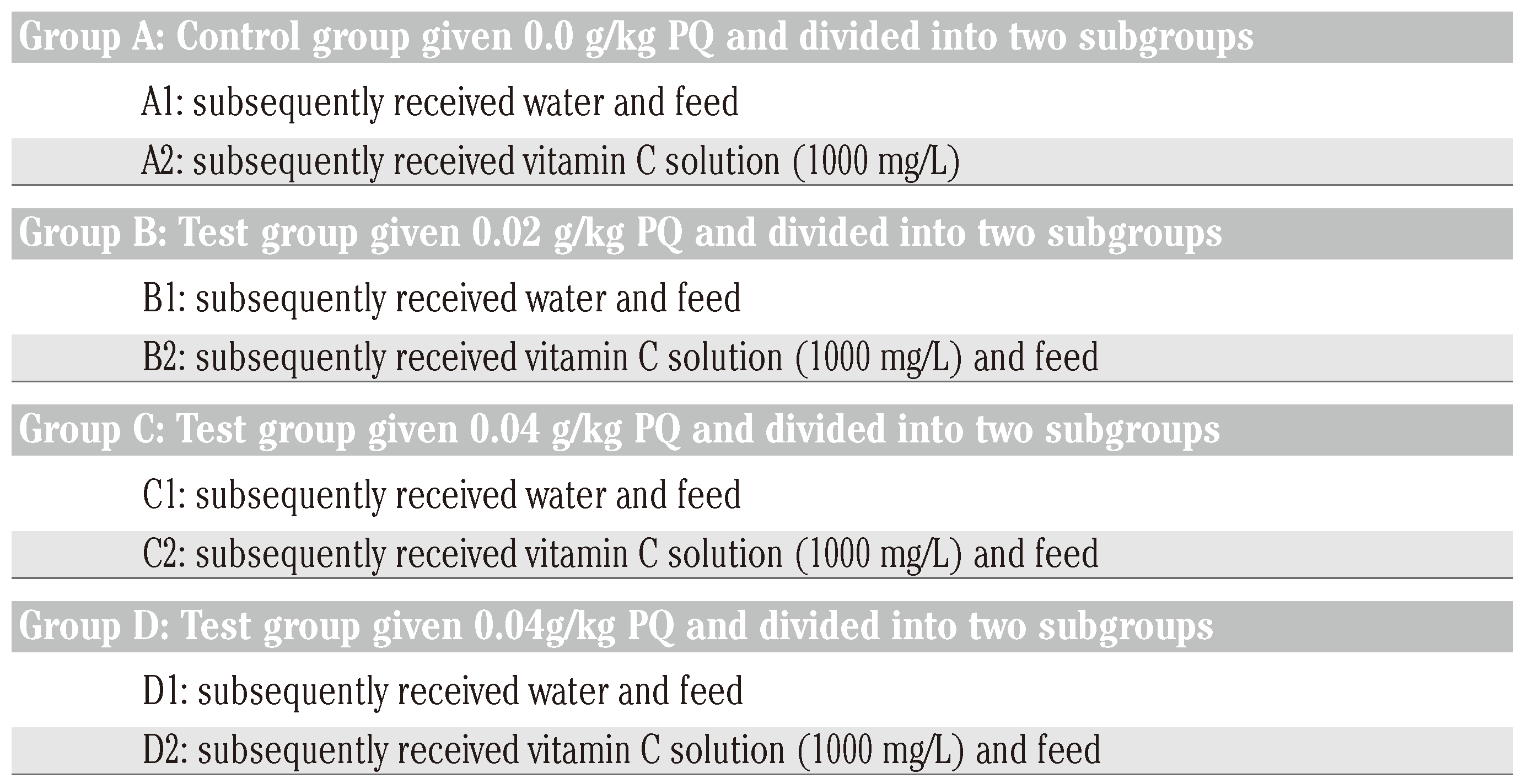The In Vivo Antioxidant Effect of Vitamin C on Hemogram in Paraquat Treated Male Rats (Rattus norvegicus)
Abstract
:Introduction
Materials and Methods
Materials
Rats
Paraquat
Vitamin C
Methods
Animal care
Data computation
Results
Discussion
Conclusions
Author Contributions
Conflicts of Interest
References
- IPCS-INCHEM International programme on chemical safety. Environmental Health Criteria 39. Paraquat and diquat; 1984. Available online: http://www.inchem.org/ documents/ehc/ehc/ehc39.htm.
- Punchard, N.A.; Kelly, F.J.; (Eds), *!!! REPLACE !!!*. Free radicals: A practical approach. IRL Press: Oxford, UK, 1996. [Google Scholar]
- Bain, B.J. Blood cells: A practical guide, 2nd ed.; Blackwell Science: Malden, MA, USA, 1995. [Google Scholar]
- Dacie, J.V.; Lewis, S.M. Practical haematology, 8th ed.; Churchill Livingstone: Edinburgh, UK, 1994. [Google Scholar]
- Cheesbrough, M. Haematological tests: District laboratory practice in tropical countries. Part 2; Cambridge University Press: Cambridge, UK, 2000; pp. 267–387. [Google Scholar]
- Evantt, B.L.; Gibbs, W.N.; Lewis, S.M.; McArthur, J.R. Fundamental diagnostic haematologyanaemia. World Health Organization & US Department of Health & Human Services, CDC 2nd edition. WHO, 1211, 27; WHO Publications: Geneva, Switzerland, 1992. [Google Scholar]
- Foyer, C. Ascorbic acid. In antioxidants in higher plants; Alscher, R.G., Hess, J.L., Eds.; CRC Press: Boca Raton, FL, USA, 1993; pp. 31–58. [Google Scholar]
- Asada, K. Ascorbate peroxidase – hydrogen peroxide – scavenging enzyme in plants. Physiol Plant 1992, 85, 235–241. [Google Scholar] [CrossRef]
- Loewus, F.A. Ascorbic acid and its metabol- ic products. In The biochem- istry of plants; Preiss, J., Ed.; Academic Press: New York, NY, USA, 1988; pp. 85–107. [Google Scholar]
- Meister, A. Glutathione – ascorbic acid antioxidant system in animals. J Biol Chem 1994, 269, 9397–9400. [Google Scholar] [CrossRef] [PubMed]
- Wells, W.; Xu, D.; Yang, Y.; Rocque, P. Mammalian thioltransferase (glutaredox- in) and protein disulphide isomerase have dehydroascorbate reductase activity. J Biol Chem 1990, 265, 15361–15364. [Google Scholar] [CrossRef] [PubMed]
- Shigeoka, S.; Ishikawa, T.; Tamoi, M.; Miyagawa, Y.; Takeda, T.; Yabuta, Y.; et al. Regulation and function of ascorbate per- oxidase isoenzymes. J Exp Bot 2002, 53, 1305–1319. [Google Scholar] [CrossRef] [PubMed]
- Carr, A.; Frei, B. Does vitamin c act as a pro- oxidant under physiological conditions? Faseb J 1999, 13, 1007–1024. [Google Scholar] [CrossRef] [PubMed]
- Animal Care and Ethics Committee. Blood collection in rodents and rabbits. Newcastle: ACEC, University of Newcastle; 1999. Available online: http://www.newcas- tle.edu. au/research/animal/revision/acec 29.pdf (accessed on June 2007).
- Diel, K.H.; Hull, R.; Morton, D.; Pfister, R.; Rabemampianina, Y.; Smith, D.; et al. A good practice guide to the administration of substances and removal of blood including routes and volumes. J Appl Toxicol 2001, 21, 15–23. [Google Scholar] [CrossRef] [PubMed]
- Sies, H. Strategies of antioxidant defense. Eur J Biochem 1993, 215, 213–219. [Google Scholar] [CrossRef] [PubMed]
- Buettner, G.R. The pecking order of free radicals and antioxidants, lipid peroxida- tion, alphatocopherol and ascorbate. Arch Biochem Biophys 1993, 300, 535–543. [Google Scholar] [CrossRef] [PubMed]
- Beyer, R.E. The role of ascorbate in antioxi- dant protection of biomembranes: Interac- tion with vitamin E and coenzyme Q. J Bioenerg Biomembr 1994, 26, 349–358. [Google Scholar] [CrossRef] [PubMed]
- Wefers, H.; Sies, H. The protection by ascor- bate and glutathione against microsomal lipid peroxidation is dependent on vitamin E. Eur J Biochem 1988, 174, 353–357. [Google Scholar] [CrossRef] [PubMed]
- Thakur, M.I.; Srivastava, U.S. Vitamin-E metabolism and its application. Nutr Res 1996, 16, 1767–1809. [Google Scholar] [CrossRef]
- Prussick, R.; Ali, M.A.; Rosenthal, D.; Guyatt, G. The protective effect of vitamin E on the hemolysis associated with dapsone treat- ment in patients with dermatitis herpeti- formis. Arch Dermatol 1992, 128, 210–213. [Google Scholar] [CrossRef] [PubMed]
- Bachur, N.R.; Gordon, S.L.; Gee, M.V. A general mechanism for microsomal activation of quinine anticancer agents to free radicals. Cancer Res 1978, 38, 1745–1750. [Google Scholar] [PubMed]
- Kappus, H.; Sies, H. Toxic drug effects associ- ated with oxygen metabolism, redox cycling and lipid peroxidation. Experiential 1981, 37, 1233–1241. [Google Scholar] [CrossRef] [PubMed]
- Thor, H.; Smith, M.T.; Hartzell, P.; Bellomo, G.; Jewell, S.A.; Orrenius, S. The metabolism of menadione (2–metyl–1, 4–naphtoquino- ne) by isolated hepatocytes. J Biol Chem 1982, 257, 12419–12425. [Google Scholar] [CrossRef] [PubMed]




Disclaimer/Publisher’s Note: The statements, opinions and data contained in all publications are solely those of the individual author(s) and contributor(s) and not of MDPI and/or the editor(s). MDPI and/or the editor(s) disclaim responsibility for any injury to people or property resulting from any ideas, methods, instructions or products referred to in the content. |
© 2013 by the authors. Licensee MDPI, Basel, Switzerland. This article is an open access article distributed under the terms and conditions of the Creative Commons Attribution (CC BY) license (https://creativecommons.org/licenses/by/4.0/).
Share and Cite
Okolonkwo, B.N.; Okeke, C.U.; Ibharokhonre, V. The In Vivo Antioxidant Effect of Vitamin C on Hemogram in Paraquat Treated Male Rats (Rattus norvegicus). J. Xenobiot. 2013, 3, e7. https://doi.org/10.4081/xeno.2013.e7
Okolonkwo BN, Okeke CU, Ibharokhonre V. The In Vivo Antioxidant Effect of Vitamin C on Hemogram in Paraquat Treated Male Rats (Rattus norvegicus). Journal of Xenobiotics. 2013; 3(1):e7. https://doi.org/10.4081/xeno.2013.e7
Chicago/Turabian StyleOkolonkwo, Benjamin Nnamdi, Chukwubuike Udoka Okeke, and Victor Ibharokhonre. 2013. "The In Vivo Antioxidant Effect of Vitamin C on Hemogram in Paraquat Treated Male Rats (Rattus norvegicus)" Journal of Xenobiotics 3, no. 1: e7. https://doi.org/10.4081/xeno.2013.e7
APA StyleOkolonkwo, B. N., Okeke, C. U., & Ibharokhonre, V. (2013). The In Vivo Antioxidant Effect of Vitamin C on Hemogram in Paraquat Treated Male Rats (Rattus norvegicus). Journal of Xenobiotics, 3(1), e7. https://doi.org/10.4081/xeno.2013.e7




